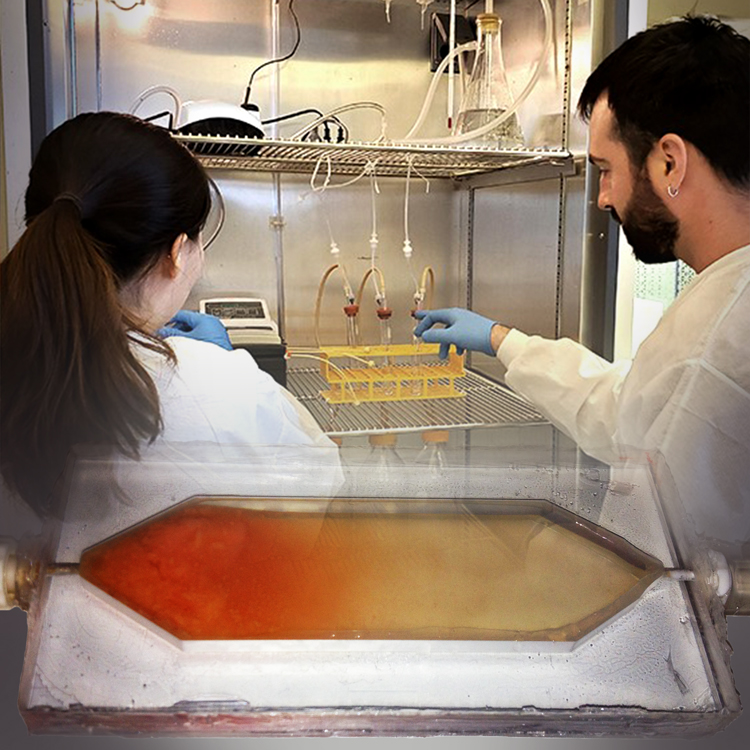Bacterial Evolution in Biofilm
May 11, 2020
In the midst of a global health crisis, the researchers in Eva Top’s lab are studying another crisis that may be just as serious. There are projections that by 2050, there could be more people dying from antibiotic resistant bacteria than from cancer.
This issue is not a new one. Though antibiotics have saved millions of lives, as soon as we began using them, bacteria began to adapt and develop resistance. Additionally, the pipeline of new antibiotics is running dry, and the more we use antibiotics, the more bacteria become resistant to them.
Trying to find a solution, the Top lab members, including Research Support Scientist Dr. Thibault Stalder, specialize in the study of multi-drug resistant plasmids in bacteria. Stalder was the lead author on a paper published in Molecular Biology and Evolution on February 6 that questions how the evolution of plasmids and bacteria is affected when grown in biofilm. Plasmids are mobile genetic elements contained in bacteria; they can carry genes that confer resistance to antibiotics and are a main driver of the current antibiotic resistance crisis.
Most bacteria on Earth—from 40 to 80%—grow in biofilm. Biofilm is made up of bacteria growing on surfaces, stacking on top of each other and creating layers which can be visible. It looks like slime and can be found anywhere from your kitchen sink to rocks in streams. However, in labs, bacteria are studied as free-living cells (i.e. planktonic cells) in well shaken test tubes, which does not accurately represent the habitat in which most bacteria actually grow.
The Top lab studies how bacteria evolve to acquire and retain resistant genes from plasmids. The studies using lab-grown bacteria have shown that exposure to antibiotics boosts the ability of bacteria to retain their resistant genes, even after the antibiotics are removed. “In this study we wanted to determine the evolutionary trajectories leading bacteria to better retain their resistant genes when bacteria evolved in biofilm rather than a well-shaken test tube†says Stalder.
Stalder’s paper, done in collaboration with Dr. Larry Forney (UI) and Dr. Benjamin Kerr (UW), discusses the evolution of plasmids and bacteria when grown in biofilm versus in a free-floating environment. In a well-mixed environment, bacteria are in constant competition, and if one bacterium has a beneficial mutation, it will easily outlive the others. The authors predicted that, since the biofilm’s stacked matrix structure protracts selective sweeps of beneficial mutations, each subgroup of a population will experience different trajectories of evolution depending on where they are in the biofilm. Consequently, the bacterial population will have more genetic variants (i.e. more individual bacteria with different mutations) and a higher chance of retaining their resistant genes from plasmids.
Stalder and colleagues inoculated a bacterium with a resistant plasmid in two environments—one well-mixed, and one that promoted the growth of biofilm. After a month of growing, they gathered the bacteria and looked first at the mutations in each population. “We found that the diversity of unique mutations was greater in the biofilm population compared to the one in the chemostat, which confirmed that biofilm generates more diversity,†says Stalder. “We also found that the frequency of those mutations was lower. So, we had potentially a lot of variants present in low frequency in the biofilm population.†They looked next at individual mutants and measured their ability to retain the resistance conferred by the plasmid. Stalder says, “We found that among the diverse mutants that evolved in the biofilm, there were few that evolved to better retain the resistant genes, which didn’t happen in the well-mixed environment.†The biofilm population not only sustained a higher diversity of mutations, but “contained a few variants with markedly more persistent plasmids, and those plasmids had different evolutionary trajectories — meaning the bacteria were able to better retain their plasmid due to different mutations or combinations of mutations.â€
The Top lab is not currently pursuing a specific line of research for biofilm beyond this paper, but Stalder says “this study brings to light how the habitat where bacteria live and evolve can drive evolution of antibiotic resistance.†In the future, Stalder says it would be interesting to use clinically relevant bacteria models and sample biofilms throughout time and space to untangle the evolutionary dynamics in biofilm that drive the evolution of antibiotic resistance. Stalder’s research draws connections between laboratory discoveries and real-life environments and brings us one step closer to solving the antibiotic and multi-drug resistance crisis.
Article by Katy Riendeau
IBEST Design & Marketing Coordinator